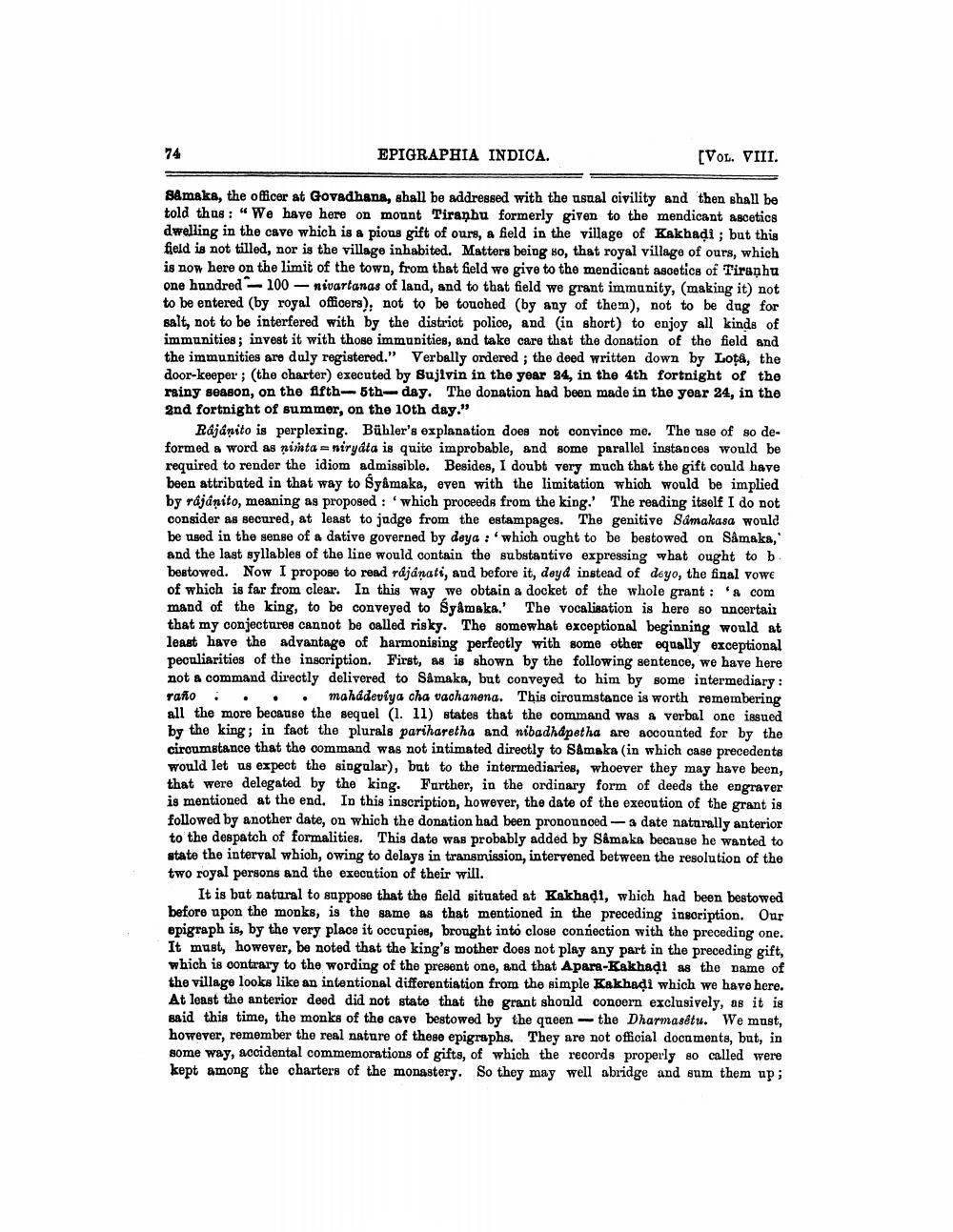________________
74
EPIGRAPHIA INDICA.
[VOL. VIII.
Samaka, the officer at Govadhana, shall be addressed with the usual civility and then shall be told thus: “We have here on mount Tiranbu formerly given to the mendicant ascetics dwelling in the cave which is a pious gift of ours, a field in the village of Kakhadi ; but this field is not tilled, nor is the village inhabited. Matters being so, that royal village of ours, which is now here on the limit of the town, from that field we give to the mendicant ascetics of Tiranhu one hundred - 100 - nivartanas of land, and to that field we grant immunity, (making it) not to be entered (by royal officers), not to be touched (by any of them), not to be dug for salt, not to be interfered with by the district police, and (in short) to enjoy all kinds of immunities; invest it with those immunities, and take care that the donation of the field and the immunities are duly registered." Verbally ordered; the deed written down by Lota, the door-keeper ; (the charter) executed by Sujivin in the year 24, in the 4th fortnight of the rainy season, on the Afth-5th-day. The donation had been made in the year 24, in the and fortnight of summer, on the 10th day."
Rajánito is perplexing. Bühler's explanation does not convince me. The use of so deformed a word as niminta = niryata is quite improbable, and some parallel instances would be required to render the idiom admissible. Besides, I doubt very much that the gift could have been attributed in that way to Syamaka, even with the limitation which would be implied by rájánito, meaning as proposed : 'which proceeds from the king. The reading itself I do not consider as secured, at least to judge from the estampages. The genitive Såmakasa would be used in the sense of a dative governed by deya : 'which ought to be bestowed on Sâmaka, and the last syllables of the line would contain the substantive expressing what ought to b bestowed. Now I propose to read rájánati, and before it, deyd instead of doyo, the final vowe of which is far from clear. In this way we obtain a docket of the whole grant : & com mand of the king, to be conveyed to Sy&maka.' The vocalisation is here so nacertain that my conjectures cannot be called risky. The somewhat exceptional beginning would at least have the advantage of harmonising perfeotly with some other equally exceptional peculiarities of the inscription. First, as is shown by the following sentence, we have here not & command directly delivered to Sâmaka, but conveyed to him by some intermediary: raño . . . mahadeviya cha vachanena. This circumstance is worth remembering all the more because the sequel (1. 11) states that the command was & verbal one issued by the king; in fact the plurals pariharetha and nibadhapetha are accounted for by the circumstance that the command was not intimated directly to Samaka (in which case precedente would let us expect the singular), but to the intermediaries, whoever they may have been, that were delegated by the king. Further, in the ordinary form of deeds the engraver is mentioned at the end. In this inscription, however, the date of the execution of the grant is followed by another date, on which the donation had been prononnoed - 3 date naturally anterior to the despatch of formalities. This date was probably added by Såmaka because he wanted to state the interval which, owing to delays in transmission, intervened between the resolution of the two royal persons and the execution of their will.
It is but natural to suppose that the field situated at Kakhadi, which had been bestowed before upon the monks, is the same as that mentioned in the preceding insoription. Our epigraph is, by the very place it occupies, brought into close connection with the preceding one. It must, however, be noted that the king's mother does not play any part in the preceding gift, which is oontrary to the wording of the present one, and that Apara-Kakhadi as the name of the village looks like an intentional differentiation from the simple Kakhadi which we have here. At least the anterior deed did not state that the grant should conoern exclusively, as it is said this time, the monks of the cave bestowed by the queen - the Dharmasêtu. We must, however, remember the real nature of these epigraphs. They are not official documents, but, in some way, accidental commemorations of gifts, of which the records properly so called were kept among the charters of the monastery. So they may well abridge and sum them up;




